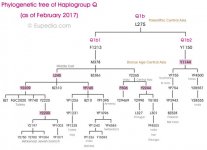Install the app
How to install the app on iOS
Follow along with the video below to see how to install our site as a web app on your home screen.

Note: This feature currently requires accessing the site using the built-in Safari browser.
You are using an out of date browser. It may not display this or other websites correctly.
You should upgrade or use an alternative browser.
You should upgrade or use an alternative browser.
Why scandinavia have q hablogroup?
- Thread starter XipeTotek
- Start date
gokturk empires was not connection scandinavia. also ashina clan belong r1a indo european y-dna.
so you mean gokturk empires only with ashina clan and r1a? so you mean turkic peoples only have r1a hablogroup?
turks are mixed of caucasoid/mongoloid. hunnic / scythians mixed = gokturk = turk
in scandinavia we can see r1a and q hablogroups. so hunnic-gokturk empires mixed of r1a and q.
and scandinavia - central asia so close areas.
not gokturk maybe but hunnic tribes have a good connection, also attila.
i think gokturks possible too. because so many similar things mythology. and bilge kağan similar with oden in turkic mythology.
if you look at scandinavian mythology they say some people come with leader oden with asian tribes.
i think they are turkic peoples and come with r1a + q hablogroups.
if they are not turks possible to native americans. because iceland - america - vikings connection.

Scandinavian Q1a
The oldest evidence to date of the presence of haplogroup Q is Europe are Q1a2-L56 samples from Mesolithic Latvia tested by Mathieson et al. (2017) and from the Khvalynsk culture (5200-4000 BCE), excavated in the middle Volga region and tested by Mathieson et al. (2016). The Khvalynsk culture is ancestral to the Yamna culture, which represents the Late Copper Age and Early Bronze Age homeland of the Proto-Indo-European speakers. Q1a2 could have travelled alongside haplogroup R1a-Z284 (via Poland) or R1b-U106 (via the Danube) to Scandinavia, or have been present there since the Mesolithic, as in Latvia. Both scenarios are possible as modern Scandinavians belong to two distinct branches of L56: Y4827 and L804. In either cases, all modern carriers of each branch seem to descend from a single ancestor who lived only some 3,000 years ago, during what was then the Nordic Bronze Age.
- Q1a (L472, MEH2) : found among the Koryaks of eastern Siberia
- Q1a1 (F1096)
- Q1a1a (F746)
- Q1a1a1 (M120) : observed in Mongolia, Japan and India
- Q1a1b (M25) : observed in Mongolia, Siberia, northern India, the Middle East, Italy and Ireland
- Q1a1b1 (L712): found in Central & Eastern Europe (probably Hunnic and/or Mongolian)
- Q1a1b1a (L713)
- Q1a1b1 (L712): found in Central & Eastern Europe (probably Hunnic and/or Mongolian)
- Q1a1a (F746)
- Q1a2 (L56, M346): found in Kazakhstan, Russia, Armenia and Hungary
- Q1a2a (L53): found among the Mongols
- Q1a2a1 (L54)
- Q1a2a1a (CTS11969)
- Q1a2a1a1 (M3): the main subclade of Native Americans
- Q1a2a1a2 (L804): found in Germany, Scandinavia and Britain
- Q1a2a1a2a (L807): observed in Britain
- Q1a2a1b (Z780): found among Native Americans, notably in Mexico
- Q1a2a1c (L330): the main subclade of the Mongols, also found among the Kazakhs and Uzbeks, as well as in Ukraine, Turkey and Greece (probably Mongolian and Turkic)
- Q1a2a1a (CTS11969)
- Q1a2a1 (L54)
- Q1a2b (L940): found in Central Asia, Afghanistan, India, Russia, Georgia, Hungary, Poland and Germany
- Q1a2b1 (L527): found almost exclusively in Scandinavia and places settled by the Vikings
- Q1a2b2 (L938): observed in Anatolia, Lithuania, Britain and Portugal
- Q1a2b2a (L939): observed in Britain
- Q1a2c (M323)
- Q1a2a (L53): found among the Mongols
- Q1a1 (F1096)
- Q1b (L275): found among the Tatars of Russia, in Central Asia, Afghanistan and Pakistan
- Q1b1 (M378): observed in Kazakhstan, India and Germany
- Q1b1a (L245): found in the Middle East, among the Jews, in Central Europe and in Sicily
- Q1b1a1 (L272.1): found in Sicily (probably Phoenician)
So same branch of Q1a2-L56 found in kazakhstan, russia, armenia, hungary and scandinavia
- Q1b1a1 (L272.1): found in Sicily (probably Phoenician)
- Q1b1a (L245): found in the Middle East, among the Jews, in Central Europe and in Sicily
- Q1b1 (M378): observed in Kazakhstan, India and Germany
This thread has been viewed 14019 times.
